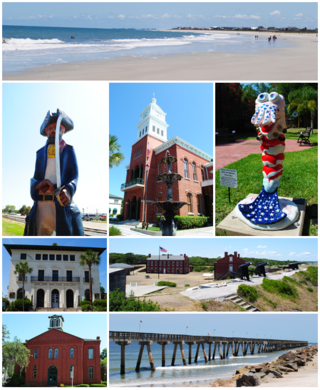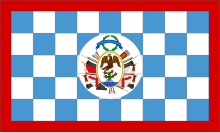
Fernandina Beach is a city in northeastern Florida and the county seat of Nassau County, Florida, United States. It is the northernmost city on Florida's Atlantic coast, situated on Amelia Island, and is one of the municipalities comprising Greater Jacksonville. The area was first inhabited by the Timucuan Indian people. Known as the "Isle of 8 Flags", Amelia Island has had the flags of the following nations flown over it: France, Spain, Great Britain, Spain (again), the Republic of East Florida (1812), the Republic of the Floridas (1817), Mexico, the Confederate States of America, and the United States.

East Florida was a colony of Great Britain from 1763 to 1783 and a province of the Spanish Empire from 1783 to 1821. The British gained control over Spanish Florida in 1763 as part of the Treaty of Paris that ended the Seven Years' War. Deciding that the colony was too large to administer as a single unit, British officials divided Florida into two colonies separated by the Apalachicola River: the colony of East Florida, with its capital located in St. Augustine; and West Florida, with its capital located in Pensacola. East Florida was much larger and comprised the bulk of the former Spanish colony and most of the current state of Florida. It had also been the most populated region of Spanish Florida, but before control was transferred to Britain, most residents – including virtually everyone in St. Augustine – left the territory, with most migrating to Cuba.

General Gregor MacGregor was a Scottish soldier, adventurer, and confidence trickster who attempted from 1821 to 1837 to draw British and French investors and settlers to "Poyais", a fictional Central American territory that he claimed to rule as "Cazique". Hundreds invested their savings in supposed Poyaisian government bonds and land certificates, while about 250 emigrated to MacGregor's invented country in 1822–23 to find only an untouched jungle; more than half of them died. Seen as a contributory factor to the "Panic of 1825", MacGregor's Poyais scheme has been called one of the most brazen confidence tricks in history.

The Sea Islands are a chain of over a hundred tidal and barrier islands on the Atlantic Ocean coast of the Southeastern United States, between the mouths of the Santee and St. Johns rivers along South Carolina, Georgia and Florida. The largest is Johns Island, South Carolina. Sapelo Island is home to the Gullah people. All of the islands are acutely threatened by sea level rise due to climate change.

Amelia Island is a part of the Sea Islands chain that stretches along the East Coast of the United States from South Carolina to Florida; it is the southernmost of the Sea Islands, and the northernmost of the barrier islands on Florida's Atlantic coast. Lying in Nassau County, Florida, it is 13 miles (21 km) long and approximately 4 miles (6.4 km) wide at its widest point. The communities of Fernandina Beach, Amelia City, and American Beach are located on the island.

Louis-Michel Aury was a French privateer operating in the Gulf of Mexico and the Caribbean during the early 19th century.

Spanish Florida was the first major European land-claim and attempted settlement-area in northern America during the European Age of Discovery. La Florida formed part of the Captaincy General of Cuba in the Viceroyalty of New Spain, and the Spanish Empire during Spanish colonization of the Americas. While its boundaries were never clearly or formally defined, the territory was initially much larger than the present-day state of Florida, extending over much of what is now the southeastern United States, including all of present-day Florida plus portions of Georgia, South Carolina, North Carolina, Alabama, Mississippi, and the Florida Parishes of Louisiana. Spain based its claim to this vast area on several wide-ranging expeditions mounted during the 16th century. A number of missions, settlements, and small forts existed in the 16th and to a lesser extent in the 17th century; they were eventually abandoned due to pressure from the expanding English and French colonial settlements, the collapse of the native populations, and the general difficulty in becoming agriculturally or economically self-sufficient. By the 18th century, Spain's control over La Florida did not extend much beyond a handful of forts near St. Augustine, St. Marks, and Pensacola, all within the boundaries of present-day Florida.
Jared Irwin was a United States representative from Pennsylvania.
Sawpit Bluff was a small settlement in East Florida during the American Revolutionary War on the site of a plantation at the mouth of Sawpit Creek where it discharges into Nassau Sound opposite the south end of Amelia Island. It was the location of a proposed rendezvous between mounted militia from Sunbury, Georgia and Continental troops under the command of Lt. Col. Samuel Elbert during the second invasion of Florida in May 1777.

The Original Town of Fernandina Historic Site, also known as "Old Town", is a historic site in Fernandina Beach, Florida, located on Amelia Island. It is roughly bounded by Towngate Street, Bosque Bello Cemetery, Nassau, Marine, and Ladies Streets. On January 29, 1990, it was added to the U.S. National Register of Historic Places as a historic site. Lying north of the Fernandina Beach Historic District, it is accessible from North 14th Street.
Pierre Lafitte was a pirate in the Gulf of Mexico and smuggler in the early 19th century. He also ran a blacksmith shop in New Orleans, his legitimate business. Pierre was historically less well known than his younger brother, Jean Lafitte. While not as much of a sailor as Jean, Pierre was the public face of the Lafitte operation, and was known for his wit and charm, in addition to his handling of the sale of smuggled goods.

Sir Edward Nicolls was an Anglo-Irish officer of the Royal Marines. Known as "Fighting Nicolls", he had a distinguished military career. According to his obituary in The Times, he was "in no fewer than 107 actions, in various parts of the world", and had "his left leg broken and his right leg severely injured, was shot through the body and right arm, had received a severe sabre cut in the head, was bayoneted in the chest, and had lost the sight of an eye."

Fort San Carlos was a military structure built in 1816 to defend the Spanish colonial town of Fernandina, Florida, now called Old Town, which occupied a peninsula on the northern end of Amelia Island. The fort, a lunette fortification, stood on the southwest side of the town next to the harbor, on a bluff overlooking the Amelia River. It was made of wood and earthworks, backed with a wooden palisade on the east side, and armed with an eight or ten gun battery. Two blockhouses protected access by land on the south, while the village was surrounded with military pickets. An 1821 map of Fernandina shows that the street plan, laid out in 1811 in a grid pattern by the newly appointed Surveyor General of Spanish East Florida, George J. F. Clarke, today preserves nearly the same layout as that of 1821. The fort occupied the area bounded by the streets Calle de Estrada, Calle de White, and Calle de Someruelos. The structure itself has disappeared and only traces remain in what is now Fernandina Plaza Historic State Park.

George J. F. Clarke was one of the most prominent and active men of East Florida during the Second Spanish period. As a friend and trusted advisor of the Spanish governors of the province from 1811 to 1821, he was appointed to several public offices under the colonial regime, including that of surveyor general.
The Port of Fernandina is located on Florida's Atlantic coast. It is used for terminal service for pulp and paper as well as steel exports, machinery, auto parts, chemicals, beverages, chemicals, building materials and food products. Container lines from the port serve routes to Colombia, Venezuela, the Dominican Republic, Haiti, Jamaica, Aruba, Curaçao and Bermuda.

Slavery in Florida occurred among indigenous tribes and during Spanish rule. Florida's purchase by the United States from Spain in 1819 was primarily a measure to strengthen the system of slavery on Southern plantations, by denying potential runaways the formerly safe haven of Florida. Florida became a slave state, seceded, and passed laws to exile or enslave free blacks. Even after abolition, forced labor continued.
St. Augustine, Florida, the oldest continuously occupied settlement of European origin in the continental United States, was founded in 1565 by Spanish admiral Pedro Menéndez de Avilés. The Spanish Crown issued an asiento to Menéndez, signed by King Philip II on March 20, 1565, granting him various titles, including that of adelantado of Florida, and expansive privileges to exploit the lands in the vast territory of Spanish Florida, called La Florida by the Spaniards. This contract directed Menéndez to explore the region's Atlantic coast and report on its features, with the object of finding a suitable location to establish a permanent colony from which the Spanish treasure fleet could be defended and Spain's claimed territories in North America protected against incursions by other European powers.

The Republic of East Florida, also known as the Republic of Florida or the Territory of East Florida, was a putative republic declared by insurgents against the Spanish rule of East Florida, most of whom were from Georgia. John Houstoun McIntosh was chosen as "Director" of the self-named Patriots in March, 1812, to receive formal Spanish capitulation at Amelia Island. In July, while under the occupation of U.S. forces, the Patriots created a constitution of government that provided for an executive office, a legislative council, and a court system. Under its provisions, on July 27 McIntosh was named "Director of the Territory of East Florida". He was later succeeded in that office by Gen. Buckner Harris. Patriots wished neither independence nor statehood in the United States; they desired annexation by the U.S., connoted by the word "Territory" in their name of the country, and as expressly declared by the delegates at their constitutional convention.

The Republic of the Floridas, also called Republic of Floridas, was a short-lived attempt, from June to December 1817, to establish an independent Florida. It was led by Gregor MacGregor, a Scottish military adventurer, and he was joined by French adventurer and soldier of fortune Louis-Michel Aury and by the Scot Richard Ambrister, whose execution by General Andrew Jackson shortly thereafter provoked an international incident. MacGregor conquered Amelia Island, the only territory the country consisted of, and raised the Green Cross of Florida flag over the Spanish Fort San Carlos.

The importation of slaves from overseas to the United States was prohibited in 1808, but criminal trafficking of enslaved people on a smaller scale likely continued for many years. The most intensive periods of piracy were in the 1810s, before the U.S. Congress passed laws with massive fines and penalties including execution for illegal importers, and in the 1850s, when pro-slavery activists decided that the solution to rapid inflation in slave prices was simply to flood the market with humans abducted from across the ocean.
















